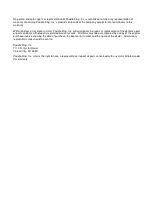
•
Make sure that at least one other passenger can operate the boat and is familiar with the safety features of
the boat in case of emergency.
•
Make sure passengers and gear do no obstruct the operator’s view or ability to move.
•
Do not exceed the maximum engine power rating posted on the certification plate attached to your boat.
Passenger Safety:
Before getting underway, show all passengers where the safety equipment is stowed and
explain how to use it. All passengers should wear shoes that provide traction on wet surfaces and provide
protection. Passengers should remain seated in seats, with both feet in the deck, inside the deck rails and gates
when underway. Passengers should never be allowed to ride while standing up or sitting on the front while
dangling their feet in the water. A sudden wave could cause them to be pulled into the water, between the two
pontoons, causing them to be run over by the outboard.
Propeller:
Do not allow anyone near the propeller, even when the engine is off. This is a dangerous place to be
and all passengers should understand this.
First Aid: A
s a boat owner, you should be familiar with basic first aid. In addition to minor cuts and fish hook
accidents, you should know how to give mouth-to-mouth resuscitation, know what to do for excessive bleeding,
hypothermia and burns. First aid literature and courses are available through the Red Cross.
Operation of Boat by Minors:
Minors should always be supervised by an adult whenever operating a boat. Please
check your state’s laws regarding the minimum age and licensing requirements of minors.
Rules of the Road:
As a responsible boater, you will comply with the “Rules of the Road,” The marine traffic laws
enforced by the U.S. Coast Guard. Navigating a boat is much the same as driving an automobile. Operating
either one responsibly means complying with a set of rules intended to prevent accidents. Just as you assume
other car drivers know what you are doing, other boaters assume you know what you are doing.
Carbon Monoxide:
Burning a material containing carbon produced a gas called carbon monoxide (CO), an
odorless, colorless gas. Carbon monoxide cannot be seen or smelled, and because it weighs the same as air, it
will distribute throughout an enclosed space without your knowledge. Any device used to burn carbon based
materials on your boat or those around you can be a source of CO. Common sources of carbon monoxide include
internal combustion engines and open flame devices such as charcoal grills.
The lungs absorb carbon monoxide which then reacts with the blood to reduce the blood’s ability to carry oxygen.
The reduced oxygen supply to body tissues results in death of the tissue. Prolonged exposure can cause death.
In high concentrations, CO can be fatal within minutes. The effects of CO in lower concentrations are cumulative
and can be just as lethal over long periods of time. Symptoms of CO poisoning include: itchy and watery eyes,
flushed appearance, throbbing temples, inability to think coherently, ringing in the ears, tightness across the chest,
headaches, drowsiness, nausea, dizziness, fatigue, vomiting, collapse and convulsions.
If you observe any of these symptoms, begin treatment immediately. Prompt action can make the difference
between life and death. Evacuate the area and move the victim to fresh air. Administer oxygen if available and
get medical help.
Open all canvas to ventilate the area. Investigate the source of CO and take immediate corrective action; be
especially aware of sources adjacent to the boat.
Carbon Monoxide Accumulation:
Keep exhaust outlets clear of blockage. Provide adequate ventilation.
The following situations are examples of how CO can accumulate with enclosed areas of your boat while docked,
anchored or underway. Become familiar with these examples and their precautions:
•
Generator or hull exhaust from other vessels while either docked or anchored can accumulate within
enclosed areas of your boat. Be alert for exhaust from other vessels alongside.
•
Under certain conditions, tail wind, boat speed, or high bow angle can draw carbon monoxide into
enclosed areas (back drafting). CO can accumulate to dangerous levels without proper airflow.
Summary of Contents for Lo Pro Cruiser
Page 23: ......







































